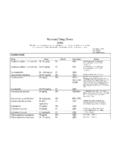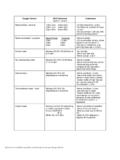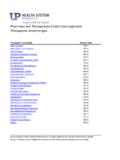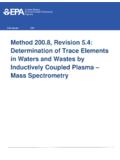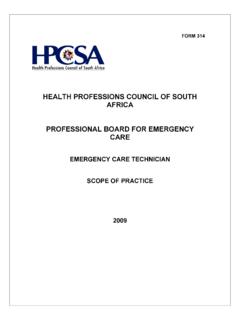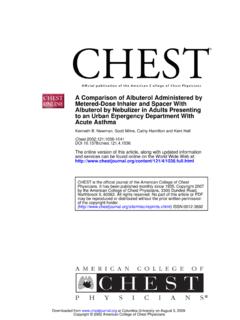Transcription of The safety of nebulization with 3 to 5 ml of adrenaline (1 ...
1 1931. PhD. Universidade Federal do Rio Grande do Sul (UFRGS), Porto Alegre,RS, Resident received Oct 26 2004, accepted for publication Mar 16 citation: Zhang L, Sanguebsche LS. The safety of nebuliza-tion with 3 to 5 ml of adrenaline (1:1000) in children: an evidence basedreview. J Pediatr (Rio J). 2005;81 : To present the evidence regarding the safety of nebulization with 3-5 ml of adrenaline (1:1000)for the treatment of children with acute inflammatory airway of data: An electronic search was undertaken, using mainly Medline databases (January of 1949-July of 2004).
2 The study inclusion criteria for this review were: 1) randomized clinical trial; 2) Patients (up to12 yrs) with diagnosis of bronchiolitis or laryngotracheobronchitis; 3) use of adrenaline (1:1000) bynebulization. The principal data extracted from the trials included adrenaline dosages and their effects on heartrate and blood pressure and any other side of the findings: Seven clinical trials with a total of 238 patients were included for this of the five trials in which larger dosages (> 3 ml) of adrenaline were used demonstrated a significantincrease in heart rate.
3 The mean increase in heart rate varied from seven to 21 beats per minute, up to 60minutes after treatment. The highest incidence of pallor was observed in one trial with 21 children treated bynebulization with 3 ml of adrenaline ( in the adrenaline group vs. in the salbutamol group, 30minutes after treatment). Two clinical trials failed to observe a significant effect on blood pressure fromnebulization with adrenaline (4 and 5 ml).Conclusion: Evidence shows that nebulization with 3 to 5 ml of adrenaline (1:1000) is a safe therapy, withminor side-effects, for children with acute inflammatory airway Pediatr (Rio J).
4 2005;81(3):193-7: adrenaline , nebulization , laryngotracheobronchitis, bronchiolitis, de PediatriaCopyright 2005 by Sociedade Brasileira de PediatriaREVIEW ARTICLEThe safety of nebulizationwith 3 to 5 ml of adrenaline (1:1000) in children:an evidence based reviewLinjie Zhang1, Lucas Soares Sanguebsche2 IntroductionAdrenaline (epinephrine) is a potential stimulant of - and fl-adrenergic receptors. In addition to its widespreaduse in cardiopulmonary resuscitation, adrenaline has beenadministered, via inhalation, to children with acuteobstructions of the airways, caused by inflammatoryprocesses such as laryngotracheobronchitis (croup) It is believed that the clinical benefits ofadrenaline in acute airway obstruction treatment are theresult of the following pharmacological effects.
5 A reductionin respiratory secretions and respiratory mucosa edema( -adrenergic effects) and a relaxation of airway smoothmuscle and inhibition of the inflammatory process(fl-adrenergic effects).1,4 Despite these theoreticalpharmacological properties, a recent meta-analysis did notdemonstrate significant effects from the use of adrenalinewith infants admitted to hospital for , the benefits of inhaled adrenaline to childrenwith laryngotracheobronchitis were fully confirmed. Initially,the effects of racemic adrenaline were explored,6-9 however,two recent clinical trials have demonstrated efficacy andsafety when nebulizing children with laryngotracheobronchitisusing 4 and 5 ml of standard adrenaline (1:1000).
6 10,11 Based on the results of these studies, the internationalliterature on management of children withlaryngotracheobronchitis recommends nebulization with racemic adrenaline at , diluted in 2-3 ml of saline,or with 3 to 5 ml of standard adrenaline (1:1000).1-3 InBrazil only standard adrenaline is available. There is greatvariation in terms of the adrenaline dosages recommendedin Brazilian literature for children The majority of authorsrecommend lower doses, varying from to 3 ml ofadrenaline, diluted in 2 ml of ,13,15 However,194 Jornal de Pediatria - Vol.
7 81, , 2005 safety of nebulization with adrenaline Zhang L & Sanguebcshe LSefficacy of nebulization with adrenaline at lower doses hasnot yet been adequately assessed in children withlaryngotracheobronchitis. We have observed thatnebulization with smaller doses of adrenaline can oftenresult in incomplete relief of the airway obstruction causedby laryngotracheobronchitis, giving rise to repeatednebulizations with adrenaline , which are rarely necessarywhen dosages are adequate. Potential side effects, such astachycardia, hypertension, arrhythmia and pallor, are themain concerns about the use of It is likely thatsuch concerns lead physicians to nebulize children withlaryngotracheobronchitis with lower doses of objective of this review is to present the evidence onthe safety of nebulization with 3 to 5 ml of adrenaline (1.)
8 1000) for the treatment of children with acuteinflammatory obstruction of the of studiesThe MEDLINE electronic database (January 1949 to July2004) was used to identify studies. The keyword searchstring used was: ( adrenaline OR epinephrine) AND (laryn*OR croup OR bronchiolitis) AND (nebul* OR inhal*). Searchlimits set were: All child: (0-18 years), Clinical trial andHumans. Additional searches were performed on the LILACSand Cochrane Controlled Clinical Trials Register bibliographical references cited by the articles foundwere also investigated to identify further selectionThe selection of studies was performed in two two authors independently examined the title,abstract and keywords of the articles identified by theelectronic databases in order to select potentially relevantstudies with a view to a more detailed reading of the fulltext.
9 After reading the full texts, the two authorsindependently decided whether or not to include eacharticle in the review. Studies were included when, in theopinion of the authors, all of the following criteria weremet: 1) randomized clinical trial; 2) patients diagnosedwith bronchiolitis or laryngotracheobronchitis, aged 18 orless; 3) using adrenaline (1:1000) via agreement between the two authors wasassessed (Kappa: ) and disagreements resolved and management of dataThe two authors independently extracted data from theselected studies, using a predefined table.
10 Data collatedincluded number and age group of patients studied, dosesof adrenaline given, effects of adrenaline on heart rate andarterial pressure systemic, in addition to any other sideeffects of adrenaline . This data, extracted by the twoauthors, was then compared to check for errors. Side effectsof 3 to 5 ml nebulized adrenaline and also of smaller dosesof the drug were listed clinical trials were selected for the review. Fivetrials evaluated the effects of adrenaline onbronchiolitis,4,17-20 and two on ,11 Table 1 shows the characteristics of theseven clinical trials.










